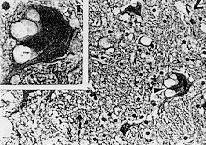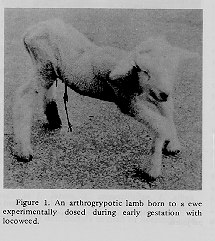Swainsonine Poisoning
A number of Astragalus carry swainsonine as their primary toxic principle. Some of these are:
- A. argillophilus - Halfmoon Locoweed
- A. asymmetricus - Horse Locoweed
- A. mollisimus - Woolly or Purple Locoweed
- A. lentiginosus - Freckled Milkvetch
- A. nothoxys - Sheep Locoweed
- A. oxyphysus - Stanislaus Milkvetch
- A. pubentissimus - Green River Milkvetch
- A. thurberi - Thurber Milkvetch
- A. wootonii - Wooton Milkvetch
- A. lusitanicus - Locoweed
(James and Welsh, 1992)
Remember, however, that nearly all of the genus carries more than one of the previously mentioned toxins. The above list is those Astragali that carry high levels of swainsonine and have a range and large enough popultion to make them a threat.
Chronic ingestion of swainsonine causes a number of different problems:
- Locoism
- Birth Defects
- Reproductive Problems
- Congestive Heart Failure
- Edema
- Growth Retardation
- Loss of Body Condition
The terms locoism and locoweed derive from the spanish word for "crazy". The clinical signs of locosim include aggression, hyperactivity, a stiff and clumsy gait, low head carriage, salivation, seizures, apparent blindness, increasing miscoordination, weakness and death. (Dorling et al. 1984, El-Hamidi and Leipold, 1989) One can imagine how this name came to be - if an otherwise calm animal became aggressive, running around with an odd gait, running into objects with its head held low and finally keeling over dead - "crazy" is an apt description.
 These symptoms are attributed to lysosomal storage disease. Otherwise known as foamy cytoplasmic vacuolation of central nervous system cell viscera, as shown to the right in a histosection from the brain stem of a sheep fed A. lusitanicus. (illustration from El-Hamidi et al. 1989) The inset is a magnification of the area shown by the arrow. Note the globular white masses in the dark area in the inset. Those are vacuoles which are filled with the partially processed oligosaccharides and glycoproteins of the cell, in storage because the necessary enzymes for processing them are inhibited by the presence of swainsonine.
These symptoms are attributed to lysosomal storage disease. Otherwise known as foamy cytoplasmic vacuolation of central nervous system cell viscera, as shown to the right in a histosection from the brain stem of a sheep fed A. lusitanicus. (illustration from El-Hamidi et al. 1989) The inset is a magnification of the area shown by the arrow. Note the globular white masses in the dark area in the inset. Those are vacuoles which are filled with the partially processed oligosaccharides and glycoproteins of the cell, in storage because the necessary enzymes for processing them are inhibited by the presence of swainsonine.
In milder cases, the removal of the animal from locoweed infested areas can reverse the condition of locoism. However, it is often the case that by the time symptoms are apparent, irreversible neural damage has been done.
 Although the mechanism by which swainsonine causes birth defects is unkown, research has shown that the sorts of defect it causes and the time period over which it exerts an effect are very broad. Most of the deformities are characterized by curvature and/or rigidity of limbs, hypermobility of many limb joints as well as rigidity of the carpal joints (arthrogryposis). Although it is clear through comparison with the birth defects from mothers with genetic lysosomal storage disease that swainsonine is responsible for at least part of the defects, it is not certain yet whether it is the sole agent acting as a teratogen in these cases. Since the studies done to date are all based on results from feeding animals whole plants, there could quite possibly be more than one agent acting.(Keeler, 1988)
Although the mechanism by which swainsonine causes birth defects is unkown, research has shown that the sorts of defect it causes and the time period over which it exerts an effect are very broad. Most of the deformities are characterized by curvature and/or rigidity of limbs, hypermobility of many limb joints as well as rigidity of the carpal joints (arthrogryposis). Although it is clear through comparison with the birth defects from mothers with genetic lysosomal storage disease that swainsonine is responsible for at least part of the defects, it is not certain yet whether it is the sole agent acting as a teratogen in these cases. Since the studies done to date are all based on results from feeding animals whole plants, there could quite possibly be more than one agent acting.(Keeler, 1988)
In addition to the teratogenicity of swainsonine, some other effects it may have on reproduction are increased rate of embryonic loss and spontaneous abortion, decreased libido, decreased spermatogenesis and altered estrus periods(James, Panter, Molyneux, Stegelmeier, Wagstaff 1994). There is also an increased incidence of hydrops amnii or edema of the amniotic sac which can result in both increased rate of abortion and certain birth defects.(Panter and James 1984) Swainsonine is also found in significant amounts in milk so a young animal that hasn't yet been weaned can nonetheless suffer from the effects of a mother feeding on locoweed. (James et al. 1994)
Go to the Swainsonine biochemistry page
Return to the Astragalus toxicity main page